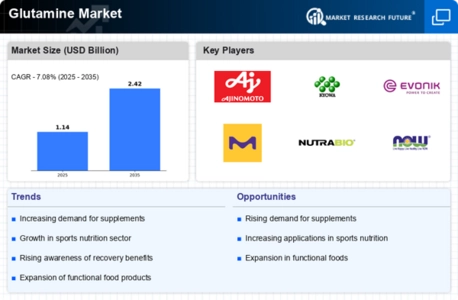The Glutamine Market is currently characterized by a dynamic competitive landscape, driven by increasing consumer awareness regarding health and wellness, alongside a growing demand for dietary supplements. Key players such as Ajinomoto (Japan), Kyowa Hakko Bio (Japan), and Evonik Industries (Germany) are strategically positioned to leverage these trends. Ajinomoto (Japan) focuses on innovation in amino acid production, emphasizing high-quality, sustainable sourcing. Meanwhile, Kyowa Hakko Bio (Japan) has been enhancing its product portfolio through research and development, particularly in the area of functional foods. Evonik Industries (Germany) is concentrating on expanding its global footprint, particularly in emerging markets, thereby enhancing its competitive edge. Collectively, these strategies indicate a shift towards a more innovation-driven market, where companies are not only competing on product quality but also on sustainability and technological advancements.
In terms of business tactics, companies are increasingly localizing manufacturing to reduce lead times and optimize supply chains. This approach appears to be particularly effective in a moderately fragmented market, where the collective influence of key players can significantly impact pricing and availability. The competitive structure is evolving, with larger firms acquiring smaller entities to enhance their market share and product offerings, thereby intensifying competition.
In August 2025, Ajinomoto (Japan) announced a partnership with a leading health food retailer to co-develop a new line of glutamine-based supplements aimed at athletes. This strategic move not only enhances Ajinomoto's product visibility but also aligns with the growing trend of personalized nutrition, potentially increasing market penetration. The collaboration is expected to leverage both companies' strengths, thereby creating a robust platform for innovation in the glutamine segment.
In September 2025, Kyowa Hakko Bio (Japan) launched a new glutamine product that incorporates advanced delivery technology, aimed at improving absorption rates. This innovation is significant as it addresses a common consumer concern regarding the efficacy of dietary supplements. By enhancing product performance, Kyowa Hakko Bio positions itself as a leader in the market, likely attracting a broader customer base and reinforcing its commitment to research-driven solutions.
In October 2025, Evonik Industries (Germany) unveiled a new sustainability initiative focused on reducing the carbon footprint of its glutamine production processes. This initiative is indicative of a broader industry trend towards sustainability, which is becoming increasingly important to consumers. By prioritizing eco-friendly practices, Evonik not only enhances its brand reputation but also aligns with regulatory trends that favor sustainable manufacturing practices.
As of October 2025, the competitive trends in the Glutamine Market are increasingly defined by digitalization, sustainability, and the integration of artificial intelligence in product development and marketing strategies. Strategic alliances are becoming more prevalent, as companies recognize the value of collaboration in enhancing innovation and market reach. Looking ahead, competitive differentiation is likely to evolve from traditional price-based competition to a focus on innovation, technological advancements, and supply chain reliability, suggesting a transformative shift in how companies approach market challenges.



.webp)
.webp)
.webp)
.webp)
.webp)
.webp)








Leave a Comment